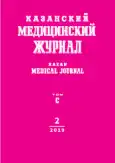Primary prevention of the main dental diseases in children at different stages of orthodontic treatment with bracket systems
- Authors: Bril’ EA1, Moiseenko SA1, Galonskiy VG1, Shishkov NY.1, Pustoshilova AS1, Bril’ VI1
-
Affiliations:
- Krasnoyarsk State Medical University n.a. V.F. Voino-Yasenetski
- Issue: Vol 100, No 2 (2019)
- Pages: 221-225
- Section: Theoretical and clinical medicine
- URL: https://journals.rcsi.science/kazanmedj/article/view/11530
- DOI: https://doi.org/10.17816/KMJ2019-221
- ID: 11530
Cite item
Full Text
Abstract
Aim. Evaluation of the effective preventive methods of dental caries in children with dentoalveolar anomalies.
Methods. Orthodontic treatment was received by 50 children aged 12-14 years with dentoalveolar anomalies who were treated by an orthodontist using ligature bracket and who had a compensated form of dental caries before the beginning of the hardware treatment. In the first group of children (control, 25 subjects) professional oral hygiene twice a year was followed by the coating of all teeth with fluoride. Children of the second group (25 subjects) after professional oral hygiene twice a year had their teeth covered with tooth enamel around brackets with Clinpro XT Varnish (3M ESPE) material containing fluorine, calcium and phosphate compounds. Dental examination every three months included assessment of oral hygiene and the state of the gums, the presence of carious defects, fillings and removed teeth, followed by the calculation of the main dental indices.
Results. On the basis of studies of the dental status in children undergoing orthodontic treatment using brackets, the main dental indices such as DCF (decay/missing/filled), complex periodontal index, papillary-marginal-alveolar index were characterized at the stages of treatment. The analysis of the recorded values was performed in the comparison groups for each research method and the main statistically significant differences were identified. The study revealed that children from group 2 had positive dynamics of the state of periodontium within 18 months: the value of papillary-marginal-alveolar index among children from group 2 decreased by 5.4 times, the value of complex periodontal index decreased by 3.5 times. Children from group 2 had a significantly lower incidence of caries compared to the control group after 18 months of remineralizing therapy: the increase of complex periodontal index among children receiving orthodontic treatment with Clinpro XT Varnish coverage twice a year was only 1.42±0.16, incidence of caries of teeth surface reduced by 55%.
Conclusion. On the basis of these studies, a comparative characteristics of the dental indices was performed at the stages of treatment using the brackets, depending on the used primary preventive measures; dental status of children at the stages of orthodontic treatment have their features: special oral hygiene tools should be guided by hygiene indices and complemented by remineralizing drugs.
Full Text
##article.viewOnOriginalSite##About the authors
E A Bril’
Krasnoyarsk State Medical University n.a. V.F. Voino-Yasenetski
Author for correspondence.
Email: vak.sibac@gmail.com
Krasnoyarsk, Russia
S A Moiseenko
Krasnoyarsk State Medical University n.a. V.F. Voino-Yasenetski
Email: vak.sibac@gmail.com
Krasnoyarsk, Russia
V G Galonskiy
Krasnoyarsk State Medical University n.a. V.F. Voino-Yasenetski
Email: vak.sibac@gmail.com
Krasnoyarsk, Russia
N Yu Shishkov
Krasnoyarsk State Medical University n.a. V.F. Voino-Yasenetski
Email: vak.sibac@gmail.com
Krasnoyarsk, Russia
A S Pustoshilova
Krasnoyarsk State Medical University n.a. V.F. Voino-Yasenetski
Email: vak.sibac@gmail.com
Krasnoyarsk, Russia
V I Bril’
Krasnoyarsk State Medical University n.a. V.F. Voino-Yasenetski
Email: vak.sibac@gmail.com
Krasnoyarsk, Russia
References
- Bril E.A., Smirnova Y.V. Frequency of occurance of dentoalveolar anomalies and deformities in the formative period occlusion. Sovremennye problem nauki i obrazovaniya. 2014; (6): 42–46. (In Russ.)
- Grulyanov A.I. Changes of microbial flora’s composition of periodontal groove during orthodontic treatment. Stomatologiya. 2012; (3): 61–64. (In Russ.)
- Modina T.N., Mamaeva E.V., Tsinekker D.A. Features of chronic hypertrophic gingivitis formation of children aged 13–15 years. Stomatologiya detskogo vozrasta i profilaktika. 2013; (2): 28–34. (In Russ.)
- Pavlovskaya Ya.V., Gioeva Yu.A, Tsarev V.N. Diagnostics of composition of periodontal pathogenic microflora in patients needed orthodontic treatment by the use of molecular genetic PCR method. Orthodontiya. 2013; (4): 6–8. (In Russ.)
- Perova E.G., Levenets A.A., Bril’ E.A. The peculiarities of various factors influence to the effectiveness of instrumental treatment of dentoalveolar anomalies and deformations in children and teenagers. Sibirskoe meditsinskoe obozrenie. 2012; (3): 75–79. (In Russ.)
- Melinda Madlena, Jolan Banoczy, Gergely Gotz et al. Effects of amine and stannous fluorides on plaque accumulation and gingival health in orthodontic patients treated with fixed appliances: a pilot study. Dental Forum. 2014; (1): 2–7. (In Russ.)
- Bayburin R.F., Baksheeva S.L. Phylogenetic changes of dentition system of the people (review of literature). Zdorov'e i obrazovanie v XXI veke. 2017; 19 (4): 96–100. (In Russ.)
- Dmitrienko S.V., Domenyuk D.A., Kokareva A.V. Transversal sizes of dental arches in the area of canines in people with physiological occlusion of permanent teeth. Sovremennye problem nauki i obrazovaniya. 2016; (3): 33–38. (In Russ.)
- Soldatova L.N., Jordanishvili A.K. Occurrence of dentoalveolar anomalies in young men living in the metropolis and its regions. Kurskiy nauchoprakticheskiy vestnik «Chelovek i ego zdorov’e». 2016; (2): 45–47. (In Russ.)
- Dmitrieva L.A., Maksimovskiy Yu.M. Terapevticheskaya stomatologiya. Natsional’noe rukovodstvo. (Therapeutic dentistry. National guide.) Moscow: GEOTAR-Media. 2009; 894 р. (In Russ.)
Supplementary files






